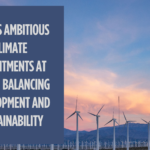
Challenges in Path to Low-Cost Financing for Energy Transition
May 28, 2023
India’s Ambitious Climate Commitments at COP28: Balancing Development and Sustainability
December 11, 2023India’s energy transition towards clean and sustainable sources is crucial for achieving its climate goals and ensuring a resilient future. However, one of the primary challenges in this transition is the availability of low-cost finance for renewable energy projects. To address this, a comprehensive set of strategies can be implemented, bringing together various stakeholders such as the government, financial institutions, and the private sector. By fostering collaboration and adopting innovative approaches, India can create an enabling environment that attracts investments, reduces costs, and accelerates the deployment of renewable energy projects.
Government Incentives and Policies
The Indian government can play a pivotal role in attracting low-cost finance by providing financial incentives and developing supportive policies. For instance, tax benefits, grants, subsidies, and accelerated depreciation can incentivize investments in renewable energy projects. Clear and stable regulatory frameworks, long-term renewable energy targets, and energy transition roadmaps will instill confidence among investors and lenders. Government incentives and policies are crucial in attracting low-cost finance for the energy transition in India. By providing financial incentives and developing supportive frameworks, the government can encourage investments in renewable energy projects.
Here are some concrete examples of government incentives and policies in India:
Generation-Based Incentives (GBIs)
The Indian government has implemented Generation-Based Incentives (GBIs) for renewable energy projects. Under this scheme, project developers receive incentives based on the amount of renewable energy generated. GBIs provide financial support in addition to the revenue generated from selling electricity. This incentive mechanism has been particularly effective in promoting wind power projects in India.
Viability Gap Funding (VGF)
To bridge the viability gap in renewable energy projects, the Indian government provides Viability Gap Funding (VGF). VGF covers a portion of the project cost to make it financially viable, thus attracting private investors. This approach has been successful in promoting renewable energy projects in challenging areas or technologies with higher costs, such as offshore wind or floating solar projects.
Direct Benefit Transfer (DBT)
The Indian government has introduced the Direct Benefit Transfer (DBT) scheme to provide financial assistance directly to beneficiaries. Under this scheme, subsidies and incentives for renewable energy projects are directly transferred to project developers’ accounts. DBT eliminates intermediaries and ensures that incentives reach the intended beneficiaries efficiently.
National Clean Energy Fund (NCEF)
The National Clean Energy Fund (NCEF) was established by the Indian government to finance clean energy projects and promote energy efficiency initiatives. The fund is primarily financed through a cess on coal consumption. NCEF provides low-cost finance through various mechanisms, including interest subsidies and grants, to encourage the deployment of renewable energy projects.
Renewable Energy Certificates (RECs)
India has implemented a Renewable Energy Certificate (REC) mechanism to promote renewable energy generation. RECs represent the environmental attributes of renewable energy produced and can be traded on power exchanges. The government mandates obligated entities, such as distribution companies, to purchase a certain percentage of their power through RECs. This creates a market demand for renewable energy and provides additional revenue streams for project developers.
These examples highlight the effectiveness of government incentives and policies in attracting low-cost finance for renewable energy projects in India. By implementing such measures, the Indian government creates a favorable investment environment, reduces project risks, and accelerates the energy transition towards a cleaner and more sustainable future.
Establishing Green Banks and Funds
The establishment of dedicated green banks or funds can leverage public and private funds to offer favorable financing options for clean energy projects. These institutions can provide low-interest loans, venture capital, and risk-sharing mechanisms, thereby enabling access to low-cost finance. The Indian Renewable Energy Development Agency (IREDA) serves as a prime example of a government-owned financial institution in India that focuses on financing renewable energy projects.
Strengthening Financial Institutions
Encouraging traditional financial institutions to increase their focus on renewable energy financing is essential for expanding access to low-cost finance. Capacity building, specialized training, and the creation of dedicated renewable energy financing divisions within banks and non-banking financial companies (NBFCs) can help meet this objective. Collaboration between financial institutions and international development banks, such as the Asian Development Bank, can enhance access to low-cost funds.
Risk Mitigation Instruments
The development and implementation of risk mitigation instruments can alleviate the perceived risks associated with renewable energy investments. Governments or financial institutions can provide guarantees or insurance against potential losses, ensuring that lenders feel more secure in providing low-cost finance. One example is the India Infrastructure Finance Company Limited (IIFCL), which offers credit enhancement facilities to renewable energy projects, reducing the perceived risks for investors.
International Cooperation and Funding
Collaborating with international organizations and leveraging international funding mechanisms can enhance access to low-cost finance. Partnerships with organizations like the International Finance Corporation (IFC) and the World Bank can facilitate the flow of affordable finance for renewable energy projects in India. The Green Climate Fund (GCF) is another example of an international fund that provides financial support for climate-related projects in developing countries.
Innovative Financing Mechanisms
Exploring and implementing innovative financing mechanisms can mobilize low-cost finance for renewable energy projects. Green bonds, for instance, can attract socially responsible investors seeking sustainable investment opportunities. Crowdfunding platforms can also be utilized to raise funds for small-scale renewable energy projects. An example of a successful innovative financing mechanism is the issuance of the world’s first blue bond by the Republic of Seychelles, which raised funds for marine conservation projects.
Public-Private Partnerships (PPPs):
Collaborating with the private sector through PPPs can unlock additional sources of low-cost finance for renewable energy projects. By combining publicly funded projects with private investments, the risks and rewards can be shared effectively. PPP models have proven successful in developing renewable energy infrastructure, such as solar parks or wind farms. For instance, the Bhadla Solar Park in Rajasthan, developed through a PPP, has attracted significant private investment and become one of the largest solar parks in the world.
Policy and Regulatory Support:
Governments have a crucial role in providing policy and regulatory support to overcome barriers and encourage low-cost finance for the energy transition. Clear and stable policy frameworks are essential for attracting investments in renewable energy and energy efficiency. Long-term renewable energy targets, implementation of feed-in tariffs or power purchase agreements, and establishing regulatory mechanisms that facilitate low-cost finance can create an environment conducive to renewable energy investments.
An example of effective policy support is the introduction of the Competitive Bidding Guidelines by the Ministry of New and Renewable Energy in India, which has led to increased competition and reduced tariffs in the solar and wind energy sectors.
Capacity Building and Knowledge Sharing
Enhancing technical capacity and knowledge sharing among stakeholders is vital for promoting low-cost finance in the energy transition. Providing training programs, workshops, and seminars to financial institutions, project developers, and government officials can help build their understanding of renewable energy financing mechanisms. Sharing best practices and success stories from both national and international contexts can inspire others to adopt low-cost finance strategies. For instance, the International Solar Alliance (ISA) established by India and France facilitates knowledge exchange and capacity building in solar energy technologies.
Examples and Context
To illustrate the effectiveness of these strategies, let’s consider the case of the Rewa Ultra Mega Solar Park in Madhya Pradesh, India. This project, developed under a public-private partnership, attracted low-cost finance through a combination of incentives, policies, and innovative financing mechanisms. The government provided land, policy support, and payment security mechanisms, reducing risks for investors. Additionally, the project implemented an innovative bundling scheme to reduce tariffs, making it one of the world’s largest solar power projects at a highly competitive price.
The successful implementation of low-cost finance strategies is crucial for accelerating India’s energy transition. By fostering collaboration among stakeholders and adopting innovative financing mechanisms, India can attract investments, reduce costs, and expedite the deployment of renewable energy projects. The government’s role in providing supportive policies and incentives, coupled with the establishment of green banks and funds, will be instrumental in driving the energy transition forward. Moreover, international cooperation, risk mitigation instruments, and capacity building efforts will further enhance access to low-cost finance. By embracing these strategies, India can pave the way for a sustainable, low-carbon future and contribute significantly to global climate action.

